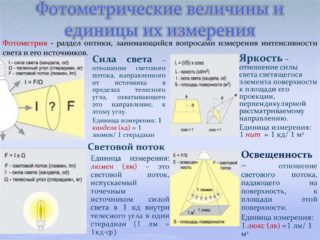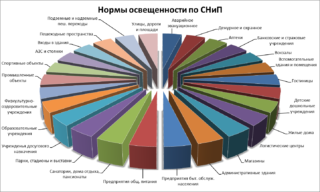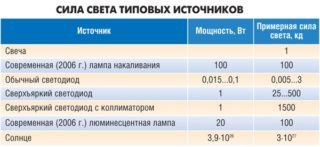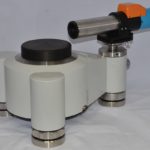To determine the amount of light per square meter of area, the concept of luminous flux is used. The value is measured in lumens and allows you to specify how much light a single lamp or lighting system gives out.
- What is luminous flux
- How illumination is related to luminous flux
- The difference between illumination and luminous flux
- Lighting standards for premises (SNiP)
- Office lighting
- Illumination intensity in production
- Warehouse lighting
- Lighting parameters in residential buildings and leisure centers
- Luminous flux calculation
- The power of light
- Watts and Lumens
- How and in what the luminous flux is measured
What is luminous flux
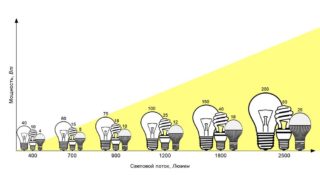
The flux of light means the power of radiation that a person can see or light energy coming from a surface (glow or reflection of a beam). The total flux, excluding the concentrated efficiency of the devices, but taking into account the useless light, is measured in lumen-seconds.
The light quantity is not an analogue of the energy quantity, which characterizes light without visual sensations. Light or radiant energy can be measured in joules. The unit of measurement of the luminous flux is lumen, which means the glow from one source with a strength of 1 candela. The solid angle in this case is 1 steradian.
The amount of radiation lumens depends on the brightness of the source.
How illumination is related to luminous flux
For clarity, you can compare the force and pressure. By using a small needle and applying a minimum of force, a high specific pressure ratio is created for a specific point. Likewise, a weak luminous flux can illuminate a specific area.
The interaction of light flux and illumination is easy to understand using the example of a table lamp with a luminous flux of 1000 lm. In order for the lighting to be complete, they are guided by the norms of SNiP 52.13330. For the workplace, a value of 350 Lux is used, for manipulating small parts - 500 Lux. The illumination is also affected by the distance from the light source, the color of foreign objects, the presence of a mirror or window. That is, a table next to a white wall will receive more suites than a table next to a dark one.
Use a lux meter or a smartphone app to measure the illumination.
The difference between illumination and luminous flux

Illumination is the surface density when the luminous flux hits the site. In a horizontal plane, the surface is illuminated in a horizontal plane. The letter E is used to indicate the value. You can calculate the illumination parameters (Lux) using the formula E = F / S, where:
- F - light flux in Lumens;
- S is the surface area in mm2.
The difference between physical values - 1 lux equals 1 lumen per m2 of illumination area.
To determine the illumination, you will need to correlate the light power with the distance to a specific area. When light hits a surface at right angles, the area of the light flux is less. As the angle increases, the percentage of illumination decreases.
Less light will hit an object located away from radiation sources.
Lighting standards for premises (SNiP)
When choosing a lighting system, they are guided by SNiP 23-05-95 from 1995 and its updated version of SP 52.13330 from 2011 for natural and artificial light sources.
Office lighting
Stress resistance, concentration of attention, mental activity of the staff will depend on the level of lighting. You can see the regulatory requirements in the table.
| Room type | Illumination, lx |
| Large office with computer equipment | 200-300 |
| Large office with a free layout | 400 |
| Office for working with drawings | 500 |
| Conference hall | 200 |
| Stairs | 50-100 |
| Halls, corridors | 50-75 |
| Archival premises | 75 |
| Back rooms | 50 |
Illumination intensity in production
To determine the indicator, the visual load is taken into account.
| Visual work, category | Eye strain | Combined lighting | General lighting |
| 1 | Highest precision | 1500-5000 | 400-1250 |
| 2 | Very high precision | 1000-4000 | 300-750 |
| 3 | High precision | 400-2000 | 200-500 |
| 4 | Average accuracy | 400-700 | 200-300 |
| 5 | Minimum Accuracy | 400 | 200-300 |
| 6 | Rough | 200 | |
| 7 | Production control (surveillance systems) | 400 | 200-300 |
Warehouse lighting
The intensity of the light sources depends on the type of storage and the type of lamp.
| Storage | Lamps | |
| Gas discharge | Incandescent | |
| On the floor | 75 | 50 |
| On shelves | 200 | 100 |
Lighting parameters in residential buildings and leisure centers
For an office, billiard room, library, the standard table height is 0.8 m from the floor line.
| Room type | Lighting, lx |
| Elevator shafts | 5 |
| Moves on floors, attics, corridors | 20 |
| Premises for communication equipment | 20 |
| Rooms for strollers and bicycles | 30 |
| Stairs | 20 |
| Concierge points | 150 |
| Bathrooms, showers, baths | 50 |
| Billiard rooms | 300 |
| GYM's | 150 |
| Changing rooms, pools, saunas | 100 |
| Dressing rooms | 75 |
| Back rooms | 300 |
| Corridors and halls in apartments | 50 |
| Libraries, offices | 300 |
| Children's room | 200 |
| Kitchen | 150 |
| Living spaces | 150 |
| Lobby | 30 |
These norms are taken into account when arranging electrical wiring and installing lighting devices.
Luminous flux calculation

To calculate the luminous flux, you can use a special measuring device or be guided by the light output indicator depending on the flux:
- LED lamp in a matte bulb - the power of the device, multiplied by 80 lm / W, will be the luminous flux;
- filament sources - lamp power is multiplied by 100 lm / W;
- energy-saving CFL devices - multiplied by 60 lm / W;
- DRL - power is required to be multiplied by 58 lm / W.
The effectiveness of the method depends on the intensity of the luminous flux in the lamp, illumination standards, safety factors (object purity and type of source), the use of the light flux, correction, the number of lamps, and the area of the room. When calculating, they are also guided by the design of the device, the presence of a protective coating.
The error of theoretical calculations is about 30%.
The power of light
Luminous intensity is understood as the value of the luminous flux divided by the solid angle within which it is located. If the light beam is set as volume, the force is spatial density. The indicator is measured in candelas (Cd).
A candela is a unit of measure for the luminous intensity that the pulsation of a wax candle has. It is equal to 1/683 W at a frequency of 540 to 1012 Hz, which corresponds to the green tint. 1 candela matches 1 lumen only if the light beam propagates at a cone angle of 65 degrees. Millikandels are used to designate directional devices - indicator LEDs, small flashlights.
Watts and Lumens
Until recently, when choosing bulbs, they were guided by power, or the number of watts. The larger it is, the higher the illumination was. Nowadays, the designation of the quality of lighting is produced in lumens.
But Watt cannot be simply translated into Lumen, since the first designation is power, and the second is the volume of light rays from sources. For transformation, you need to know the luminous efficiency (lm / W), as well as the type of lamp, the efficiency of the reflector, losses in the presence of a diffuser, the percentage of luminous flux leakage.
Instead of lengthy calculations, you should focus on the pivot table.
| Power, W | Luminous flux, Lm |
| Incandescent lamps | |
| 20 | 250 |
| 40 | 400 |
| 60 | 700 |
| 75 | 900 |
| 100 | 1200 |
| 150 | 1800 |
| Fluorescent lamps | |
| 5-7 | 250 |
| 10-12 | 400 |
| 15-16 | 700 |
| 18-20 | 900 |
| 25-30 | 1200 |
| 40-50 | 1800 |
| LED sources | |
| 3-4 | 250-300 |
| 4-6 | 300-450 |
| 6-8 | 450-600 |
| 8-10 | 600-900 |
| 10-12 | 900-1100 |
| 12-14 | 1100-1250 |
| 14-16 | 1250-1400 |
If you want to save money, replace the 1000 W incandescent light bulb with a fluorescent (25-30 W) or LED (12-15 W) fixture.
How and in what the luminous flux is measured
Light value - SP is measured in lumens. One lumen is analogous to the SP of an isotropic light source with a strength of 1 candela and an angle of 1 steradians.
In production, special devices are used for measurements. This method allows you to accurately determine the joint venture:
- A photometer is a device with a camera sphere. The reflectance of the inner part is 1. The measurement is carried out by placing a light bulb in the center of the camera and establishing a diffused light beam.
- A goniometer is a photometric device with a built-in luxmeter capable of moving around a sphere. During the integration of illumination values, the value in lumens is displayed.
Luxmeter is calibrated in absolute terms: 1 lm / m2 equals 1 lux.
An ordinary person, choosing a lamp or a lamp, does not have to delve into the exact measurement system. When replacing an incandescent device with a halogen one, it is worth remembering that watts are not lumens. The former are used to determine the power, the latter are based on illumination, and during operation, a standard lamp loses 15% of brightness, fluorescent - 30%, LED - from 5 to 10%.

